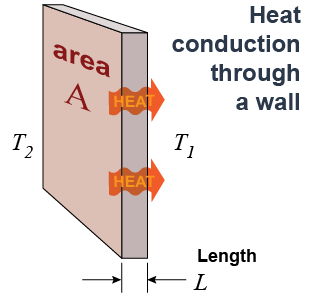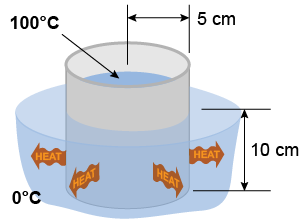|
 Many situations involve the heat flowing through a wall. The width and height of a wall are large compared to its thickness. The geometry for calculating heat conduction through a wall is shown in the diagram on the right. If T2 > T1 then heat flows from left to right through the thickness of the wall. The length L appearing in equation (24.1) is the wall thickness since that is the dimension in the direction of heat flow. The area A is the wall area, which is perpendicular to the length direction and is the area through which the heat flows.
Many situations involve the heat flowing through a wall. The width and height of a wall are large compared to its thickness. The geometry for calculating heat conduction through a wall is shown in the diagram on the right. If T2 > T1 then heat flows from left to right through the thickness of the wall. The length L appearing in equation (24.1) is the wall thickness since that is the dimension in the direction of heat flow. The area A is the wall area, which is perpendicular to the length direction and is the area through which the heat flows. 
|
| | | P | = | power (W) | | κ | = | thermal conductivity (W m−1 °C−1) | | A | = | cross-sectional area (m2) | | L | = | length (m) | | ΔT | = | temperature difference (°C) |
| Heat conduction
|
|
 Compare an aluminum cup and a foam cup of boiling water immersed in ice water at 0ºC. Both cups have a radius of 5 cm and are immersed 10 cm into the cold water. How fast does heat flow through the walls of each cup if the wall thickness is 5 mm? In this case the area through which the heat flows is the area of the cup contacting the water. The length through which the heat flows is the thickness of the cup wall.
Compare an aluminum cup and a foam cup of boiling water immersed in ice water at 0ºC. Both cups have a radius of 5 cm and are immersed 10 cm into the cold water. How fast does heat flow through the walls of each cup if the wall thickness is 5 mm? In this case the area through which the heat flows is the area of the cup contacting the water. The length through which the heat flows is the thickness of the cup wall. 
|

|
The rate of heat transfer for the aluminum cup is 176,000 W! This would initially cool the water by 112ºC per second. This heat flow is so rapid that the water near the inner surface of the cup would cool almost instantly to 0ºC. The remaining water in the middle of the cup would cool a bit more slowly. For the foam cup the heat flow is only 19.5 W, and the hot water loses only 0.01ºC per second. Both cups have the same wall thickness and contact area, but the thermal conductivity of aluminum is 226 W/(m ºC) compared to 0.025 W/(m ºC) for foam. 
 |
The different thermal properties of materials find wide application in all aspects of technology. A foam cup uses the low thermal conductivity of styrene foam to keep heat from leaking in or out. A major application for thermal insulators is in homes. Modern building codes require minimum thicknesses of insulation in roofs and walls. Modern windows are made from double-pane glass, which contains an insulating air space between the inner and outer panes. 
|
If the area of a wall is doubled and the thickness of the wall is also doubled, the heat flowing through the wall by conduction will - decrease by half.
- double.
- stay the same.
- increase by a factor of 4.
 |
The correct choice is c because the heat flow is proportional to the ratio of area divided by length. Doubling both area and the thickness of the wall leaves the ratio the same. 
|

